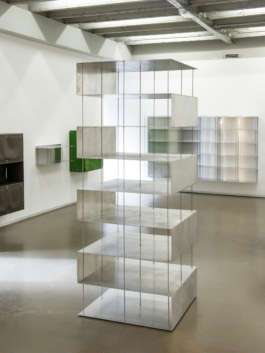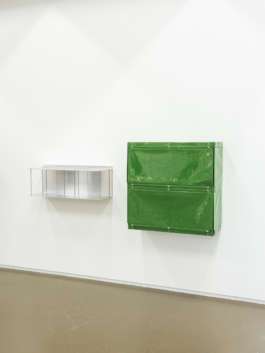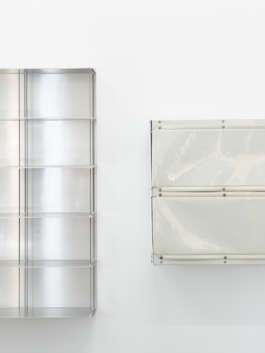



GUSCH DÜSSELDORF x Cour at COLLECTIBLE 2024. © GUSCH DÜSSELDORF x Cour
COLLECTIBLE In-Depth
March 2024
This series, COLLECTIBLE In-Depth, unveils the backstage of contemporary creation. Tackling various topics from personal designer processes to the position of collectible design on the global design market, COLLECTIBLE In-Depth offers different views to suit all tastes. Today we talk to Harry Schellenberg founder of GUSCH DÜSSELDORF & Milan Henderickx founder of COUR.
COLLECTIBLE: How do you see the relationship between late 20th century design and contemporary design? How does one feed one another?
Harry & Milan: The concept of an independent artist/designer is a misconception; all creatives draw inspiration from their environment, experiences, cultural heritage and design legacy. Understanding design evolution, artist collaborations, and creative motivations is essential for progress. While some believe ignorance stimulates originality, it also risks repetition. In our opinion, embracing the dialogue between old and new is vital for comprehending contemporary work and its influences. Fashion, with its cyclical nature, often revisits past cultural aesthetics, from minimalism to baroque, in an ever-evolving yet repetitive cycle.
C: What dialogue are you bringing this year to COLLECTIBLE?
H&M: Giseok Kim and Otto Zapf are two designers who capture the essence of their respective time periods through their minimal, technical, and sculptural designs. Zapf's work, influenced by the space age era, incorporates visual references without conforming to typical space age aesthetics. Utilizing colors and materials reminiscent of the 70s and 80s, Zapf's Softline series exude a timeless quality through clever engineering. On the other hand, Giseok's minimalist approach, characterized by silver tones and materials like aluminium, concrete, and wood, reflects a modern Korean aesthetic. Giseok's Aluminium Shelf series consists of bold, recognisable industrial materials in a functional and versatile design adaptable to various settings. Both designers contribute to a specific stream in design history, blending functionality with timeless appeal.
C: What tips would you give to a collector who wishes to start collecting contemporary design?
H&M: It's always good to place contemporary design within a historical context to discern whether it possesses genuine artistic value and quality or if it's merely a fashionable object.
C: What have you been up to recently? What are the next projects/exhibitions you wish to highlight?
M: I am thrilled to announce the upcoming launch of our COUR website later this year. It promises to be an exciting period for COUR, starting with an exhibition featuring new works by Giseok Kim and various freelance projects. One of the exciting projects in the pipeline is a collaboration with Orson Van Beek and Romain Albers, dedicated to the memory of my late father, Wim Henderickx, composer of contemporary classical music. This project involves a reimagining of his piece "Medea" through a spatial installation, serving as both a standalone sculpture and a performance backdrop, spanning the intimate tension between spatial and digital design.
C: Can you talk about the designers you present at COLLECTIBLE this year, what makes their practice/pieces unique?
H: When beginning to collect design, German artists were not typically the main focus. You would only find those large sideboards made from exotic woods or lounge chairs with a distinct German aesthetic. Zapf's Softline was different, introducing a clear shift in materials and forms. The concept of utilizing new materials and elements to enhance flexibility in use resonated with the spirit of the 1960s space age era. The minimalist art movement and fashion elements of the time also played a significant role in influencing Zapf's work during that period. Softline is like a hidden gem of design-classic, but sadly not appreciated or remembered as much as it should be.
C: What is the relation you hold with the designers you work with?
M: I studied fine arts, and after that, woodworking. While working for a sculptor and furniture designer/cabinet maker after my studies, an interest for technique and functional objects arose. COUR aims to present a mix of old and new art & design that appreciates both technical skills and sculptural elements. Working with designers like Giseok, who shares this dual appreciation, is truly inspiring. Giseok holds a special place as the first designer I represent, an important milestone for COUR. Intrigued by Giseok's 'Aluminium Shelf' design, which I found very innovative, I proposed a trial production in Belgium, which he graciously accepted. With his openness to collaboration, I was granted creative freedom to explore his design further, which made for interesting and productive conversations. Our creative relationship keeps evolving towards new perspectives with our upcoming show at COUR.

© GUSCH DÜSSELDORF x Cour

© GUSCH DÜSSELDORF x Cour
COLLECTIBLE In-Depth
March 2024

GUSCH DÜSSELDORF x Cour at COLLECTIBLE 2024. © GUSCH DÜSSELDORF x Cour
This series, COLLECTIBLE In-Depth, unveils the backstage of contemporary creation. Tackling various topics from personal designer processes to the position of collectible design on the global design market, COLLECTIBLE In-Depth offers different views to suit all tastes. Today we talk to Harry Schellenberg founder of GUSCH DÜSSELDORF & Milan Henderickx founder of COUR.
COLLECTIBLE: How do you see the relationship between late 20th century design and contemporary design? How does one feed one another?
Harry & Milan: The concept of an independent artist/designer is a misconception; all creatives draw inspiration from their environment, experiences, cultural heritage and design legacy. Understanding design evolution, artist collaborations, and creative motivations is essential for progress. While some believe ignorance stimulates originality, it also risks repetition. In our opinion, embracing the dialogue between old and new is vital for comprehending contemporary work and its influences. Fashion, with its cyclical nature, often revisits past cultural aesthetics, from minimalism to baroque, in an ever-evolving yet repetitive cycle.
C: What dialogue are you bringing this year to COLLECTIBLE?
H&M: Giseok Kim and Otto Zapf are two designers who capture the essence of their respective time periods through their minimal, technical, and sculptural designs. Zapf's work, influenced by the space age era, incorporates visual references without conforming to typical space age aesthetics. Utilizing colors and materials reminiscent of the 70s and 80s, Zapf's Softline series exude a timeless quality through clever engineering. On the other hand, Giseok's minimalist approach, characterized by silver tones and materials like aluminium, concrete, and wood, reflects a modern Korean aesthetic. Giseok's Aluminium Shelf series consists of bold, recognisable industrial materials in a functional and versatile design adaptable to various settings. Both designers contribute to a specific stream in design history, blending functionality with timeless appeal.
C: What tips would you give to a collector who wishes to start collecting contemporary design?
H&M: It's always good to place contemporary design within a historical context to discern whether it possesses genuine artistic value and quality or if it's merely a fashionable object.
C: What have you been up to recently? What are the next projects/exhibitions you wish to highlight?
M: I am thrilled to announce the upcoming launch of our COUR website later this year. It promises to be an exciting period for COUR, starting with an exhibition featuring new works by Giseok Kim and various freelance projects. One of the exciting projects in the pipeline is a collaboration with Orson Van Beek and Romain Albers, dedicated to the memory of my late father, Wim Henderickx, composer of contemporary classical music. This project involves a reimagining of his piece "Medea" through a spatial installation, serving as both a standalone sculpture and a performance backdrop, spanning the intimate tension between spatial and digital design.
C: Can you talk about the designers you present at COLLECTIBLE this year, what makes their practice/pieces unique?
H: When beginning to collect design, German artists were not typically the main focus. You would only find those large sideboards made from exotic woods or lounge chairs with a distinct German aesthetic. Zapf's Softline was different, introducing a clear shift in materials and forms. The concept of utilizing new materials and elements to enhance flexibility in use resonated with the spirit of the 1960s space age era. The minimalist art movement and fashion elements of the time also played a significant role in influencing Zapf's work during that period. Softline is like a hidden gem of design-classic, but sadly not appreciated or remembered as much as it should be.
C: What is the relation you hold with the designers you work with?
M: I studied fine arts, and after that, woodworking. While working for a sculptor and furniture designer/cabinet maker after my studies, an interest for technique and functional objects arose. COUR aims to present a mix of old and new art & design that appreciates both technical skills and sculptural elements. Working with designers like Giseok, who shares this dual appreciation, is truly inspiring. Giseok holds a special place as the first designer I represent, an important milestone for COUR. Intrigued by Giseok's 'Aluminium Shelf' design, which I found very innovative, I proposed a trial production in Belgium, which he graciously accepted. With his openness to collaboration, I was granted creative freedom to explore his design further, which made for interesting and productive conversations. Our creative relationship keeps evolving towards new perspectives with our upcoming show at COUR.

© GUSCH DÜSSELDORF x Cour

© GUSCH DÜSSELDORF x Cour
Contact
info@collectible.design
VIP PORTAL
EXHIBITOR PORTAL
PRIVACY POLICY
© 2025 Collectible
Contact
info@collectible.design
VIP PORTAL
EXHIBITOR PORTAL
PRIVACY POLICY
© 2025 Collectible